- Submissions

Full Text
Research & Development in Material Science
Observation of Compressed Relaxation Dynamics
Deepak Sharma*
SCRIET,C.C.S.University Meerut, India
*Corresponding author:Deepak Sharma, SCRIET, C.C.S. University Meerut-250004, India
Submission: August 28, 2025;Published: September 10, 2025

ISSN: 2576-8840 Volume 22 Issue 2
Abstract
UV-visible transmission measurements were performed on GexSe₁-ₓ chalcogenide glasses at room temperature over the spectral range of 200-800nm. The transmission spectra exhibited transient relaxation behavior particularly evident in the 700-800nm range. Notably, this relaxation behavior could not be adequately described using the conventional Debye model. Instead, the relaxation dynamics were analyzed using the Kohlrausch-Williams-Watts (KWW) function:
While the KWW model typically assumes stretched exponential behavior with β in the range 0<β<1, the relaxation in these samples was better described using compressed exponential functions, with β values observed in the range 2.7<β<3.5. This compressed relaxation indicates a departure from conventional glassy (liquid-like) dynamics, instead reflecting solid-like behavior. It is interpreted as arising from the clustering of atomic groups or GeSe₄/₂ tetrahedral units, where increasing structural compactness or compression leads to a decrease in characteristic relaxation time (τ). This behavior contrasts with the typical diffusive motion seen near the glass transition in more fluid-like systems. Furthermore, the analysis links the shape parameter β to the degree of structural linearity or nonlinearity, thereby relating it to micro-collapse mechanisms and dynamic heterogeneity in the glass network. The variation in β serves as a dynamic signature of the underlying structural organization, offering insight into the relationship between atomic-scale structure and macroscopic optical response.
Keywords:Debye relaxation; Chalcogenide glasses; Absorption; Nonlinearities; Photo-relaxation; Relaxation dynamics
Introduction
Extensive research has been carried out on the relaxation dynamics of glasses and polymers, particularly focusing on the α-relaxation process, which is a key feature of the glass transition. Structural relaxation is a general phenomenon occurring when a glass is maintained at a temperature near, below, or above its glass transition temperature (Tg). Over the past few decades, significant progress has been achieved in this field, driven by advancements in state-of-the-art experimental techniques, theoretical frameworks, and numerical simulations. As a result, a conceptual breakthrough appears to be emerging [1,2]. Phillips [3,4] first introduced the idea of maximum glass-forming ability in covalent random networks (CRNs), particularly near a mean atomic coordination number of ⟨r⟩=2x+2=2.4, where x refers to the atomic percentage of Ge. Concurrently, Thorpe [5] conceptualized the notions of floppy and rigid vibration modes, introducing the concept of a rigidity threshold in CRNs. Despite these advancements, room temperature relaxation studies on glasses remain relatively scarce or yet to be extensively reported. In this article, I present novel findings on transient relaxation dynamics at room temperature, obtained from transmission spectra measurements. To analyze the relaxation behavior, the Kohlrausch-Williams-Watts (KWW) compressed exponential function is employed:

This fitting function is commonly used in condensed matter physics to describe relaxation processes in complex systems such as glasses, polymers, biological materials, and metallic glasses. Here, τ is the characteristic relaxation time, and β is the KWW exponent.
The KWW exponent (β) serves as a measure of the heterogeneity of the system:
a) Values of β<1 indicate a broader distribution of relaxation times (typical for disordered systems) [6]
b) Values of β>1 suggest a narrower distribution and more uniform relaxation dynamics.
Nonlinearities observed in the experimental data were interpreted as composition-dependent features. This study provides a framework for understanding the transient relaxation dynamics of glasses, an area of interest not only from a fundamental perspective but also due to its relevance in industrial applications, such as optical fibers and fiber lasers.
Fast cooling (quenching) leads to glasses being trapped in energetically unstable configurations with greater structural disorder and higher free volume compared to slowly cool (annealed) glasses. Measurements were performed on virgin, fastquenched samples, revealing distinct relaxation behavior compared to annealed glasses. Upon annealing, glasses undergo physical aging, a process in which the system relaxes toward energetically more stable minima in the potential energy landscape. This process significantly influences the mechanical, optical, and thermal properties of glasses [7,8].
High transmittance (~90%) observed in optically polished samples demonstrates their suitability for optical applications. To minimize structural relaxation at room temperature, it is essential to use low laser power to avoid pressure-induced effects. Similar relaxation behavior may also be achieved under high-pressure conditions using high-energy synchrotron radiation. The direct band gap observed in the studied samples further supports their potential for fiber laser fabrication. With the growing demand for materials possessing high transmission in the visible, near-infrared (NIR), and mid-infrared (MIR) spectral ranges, this research contributes toward developing next-generation optical materials [9].
Experiment
Bulk glasses of the GeₓSe₁₋ₓ compositions were synthesized using the standard melt-quench technique [10,11] from high-purity (5N) elemental germanium and selenium (CERAC). The appropriate stoichiometric amounts of Ge and Se were accurately weighed and finely ground into powder. The powder mixtures were then placed into clean quartz ampoules. Each ampoule was evacuated to a vacuum level of 10-6 Torr and sealed under this vacuum. The sealed ampoules were then placed in a rocking furnace. The temperature was gradually increased at a rate of 2 °C/min until it reached 1000 °C. The samples were held at this temperature for 48 hours, with continuous rocking to ensure homogeneity. After the melting process, the ampoules were rapidly quenched in ice water to form glass. The resulting compositions were verified to within ±0.2 atomic percent Ge by inductively coupled plasma atomic emission spectroscopy (ICP-AES). X-ray diffraction (XRD) patterns of the quenched samples exhibited no sharp Bragg peaks [10,11], confirming their amorphous nature, consistent with previous reports [12,13].
Prior to further measurements, the samples were allowed to equilibrate at room temperature for 10 days and Modulated Differential Scanning Calorimeter (MDSC) scans were performed on these equilibrated samples. For optical measurements the samples were cut and polished to obtain flat surfaces. Raman scattering measurements were carried out on the same polished samples using an argon ion laser first, followed by additional measurements with a krypton ion laser. Transmission spectra for all five glass compositions were then recorded using a UV-visible spectrometer. Notably, the high flux of monochromatic laser beams used during Raman measurements exerted sufficient pressure on the samples to induce changes in their transmission spectra, even though lasers were not used during the transmission data collection itself.
Results and Discussion
In non-crystalline solids, defects such as vacancies (missing atoms), interstitials (extra atoms), and dislocations (line defects) can lead to stress and strain, which are responsible for the structural relaxation process. The decrease in transmission intensity upon photo absorption in the 700-800nm range, as shown in Figure 1, can be explained by the restructuring of bond arrangements. These defects can induce structural relaxation, leading to a red shift and an increase in the absorption coefficient, which in turn causes a reduction in transmission intensity. Light absorption into the visible region results in enhanced or tunable electron energies, significantly influenced by the electron-donating and electron-withdrawing character of constituent atoms, thereby extending absorption into the visible spectrum. However, the photo excitation process is limited by the rapid decay of photo generated charge carriers. We would like to emphasize the importance of the excitation of lone pair electrons, which plays a crucial role in bond weakening and subsequent bond breaking. This process is associated with band rearrangement, resulting in a red shift of the absorption edge and an increase in the absorption coefficient.
Hodge interpreted non-exponential relaxation as a consequence of cooperative rearranging regions near the glass transition temperature [14]. Dynamic heterogeneity is believed to be responsible for the stretched exponential decay of time observed in the liquid state of most glasses. Differential scanning calorimeter (DSC) is commonly used to study enthalpy relaxations at the glass transition. Although few studies have explored glasses that relax at room temperature, experimental investigations clearly demonstrate that transient relaxations, derived from short-time scans, enhance the super-exponential nature of relaxation. The relaxation dynamics of glass at the glass transition are directly linked to the local arrangement of tetrahedral Ge(Se₁/₂)₄ units: isolated Ge(Se₁/₂)₄ tetrahedral lead to liquid-like stretched exponential relaxation, whereas in the present analysis, a cohort of interconnected tetrahedral gives rise to compressed exponential relaxation characteristic of a solid. Since the exponent β is greater than 1, our experimental transmission scan results reveal a compressed relaxation process, suggesting an unexpectedly complex dynamic. This peculiar “squeezed” behavior can be accurately explained by structural rearrangement resulting from the micro-collapse of mesoscopic structural units during relaxation. These findings show that despite the dispersive nature of the atomic structure in chalcogenide glass, the lengths and angles of covalent bonds-as well as distances between non-bonded atoms-do not significantly change, owing to structural perturbations arising from medium-range ordering.
Structure relaxation as a function of wavelength is shown in Figure 1. The data were fitted after baseline subtraction to accurately determine the peak positions corresponding to different compositions. A direct proportionality was observed between the cluster radius and the peak position. Previous Raman scattering experiments from our earlier work indicated that the cluster sizes ranged between 7-10nm [15]. The transmission spectra analyses suggest micro-collapses of tetrahedral units and the formation of larger clusters within the samples. As a result, the free volume decreases, the clusters become compressed, and the material increasingly resembles a disordered solid. The observed increase in cluster size from the transmission spectra indicates that the glass structure becomes more compact over time. This compaction is associated with the emergence of large-scale homogenous inhomogeneities. These inhomogeneities behave as localized internal forces that deform the network. In the absence of an external net force, each inhomogeneities functions as a force dipole. The deviation from a simple exponential relaxation behaviorreferred to as non-exponentiality-is described by the Kohlrausch- Williams-Watts (KWW) function.
Figure 1:Transient Structural Relaxations as a function of Wavelength
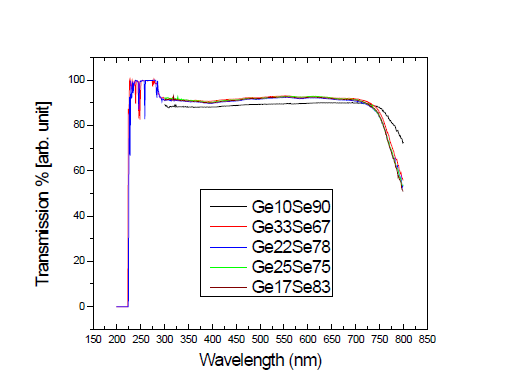
Figure 2a-2e shows the red line representing the Kohlrausch- Williams-Watts (KWW) compressed exponential fit, of the form exp[−(t/τ)β], applied to different compositions. In this expression, the time constant τ represents the structural relaxation time-i.e., the characteristic time required for the system to rearrange its structure toward equilibrium. The exponent β indicates a relatively narrow distribution of ballistic relaxation times. We extracted both the exponent β and the fast relaxation time τ as functions of composition, which are influenced by the semiconducting nature of the glasses. The compressed shape of the decay) has been associated with ballistic-like motion, which arises due to internal stresses being trapped during the structural arrest (or “freezing”) of the glassy or jammed state. The subsequent release of these stresses is observed during structural relaxation. Typically, the relaxation time for glasses at room temperature is very long, and thus the system remains in a nonergodic regime within the accessible experimental time window. Aging usually leads to a significant increase in τ, reflecting a slowing down of dynamics. However, these conventional expectations do not hold in our case. Surprisingly, we observe fast relaxation times across all samples, suggesting a different relaxation mechanism. Moreover, a temporary but pronounced decrease in τ is found in some compositions, which we attribute to large lengthscale inhomogeneities in the samples, as illustrated in Figure 3.
Figure 2(a-e):KWW fitted relaxation spectra for Ge10Se90, Ge17Se83, Ge25Se75 and Ge33Se67 respectively.
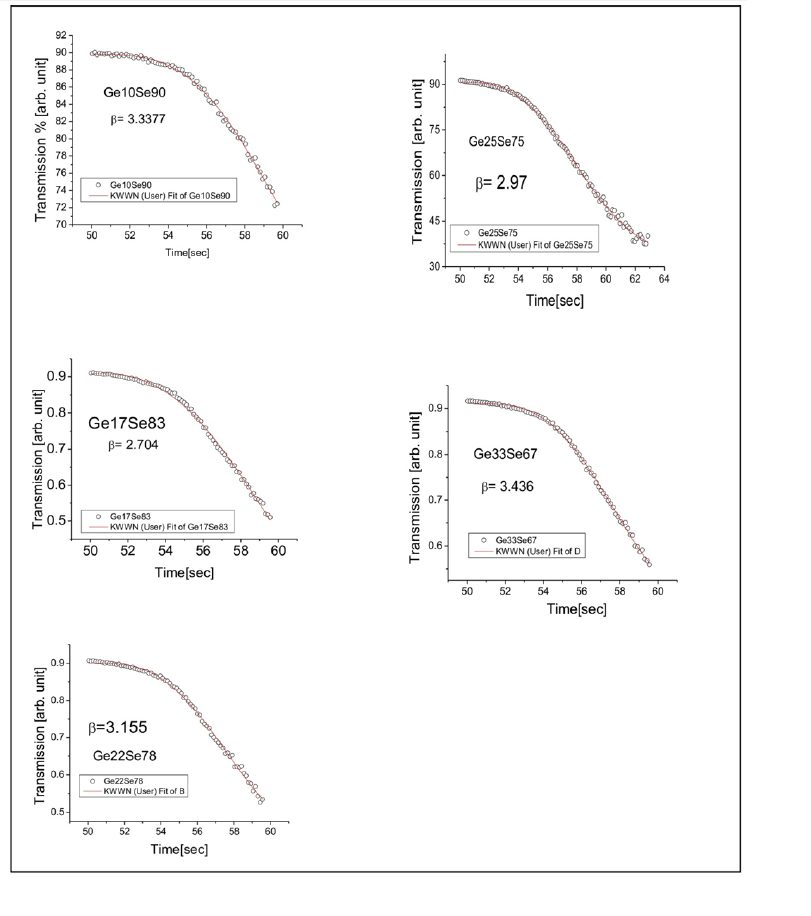
Figure 3:Relaxation time as a function of percentage of Ge in Selenium matrix.
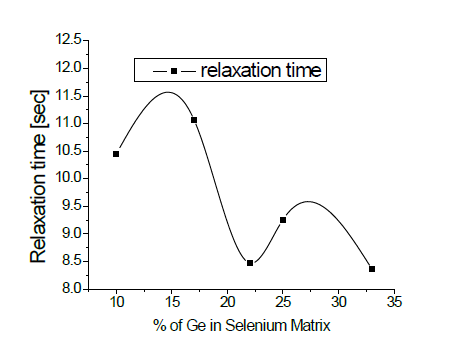
This suggests that restructuring on large length scales is accompanied by the breaking of inter-cluster bonds, which temporarily weakens the network structure [16,17] and drives transient relaxation. At the glass transition temperature, the relaxation time corresponds to cooperative dynamics. In contrast, in our case, the fast relaxation observed is attributed to the ballistic scattering motion typical of disordered solids. The variation in peak positions, obtained from the analysis of transient relaxation data across the composition range from Ge₁₀Se₉₀ to Ge₃₃Se₆₇, lies between 748.28nm and 751.88nm. These peak positions provide indirect information about the cluster size, as the cluster size is proportional to the observed peak position. To examine the association between relaxation time and cluster size during structural relaxation, we have plotted peak position versus composition (Figure 4). This is evaluated alongside relaxation time as a function of Ge content (Figure 3). These figures collectively reveal a key insight: glasses with higher Ge content (i.e., denser glasses) exhibit faster relaxation due to enhanced carrier mobility.
Figure 4:Variation of peak position with % of Ge in Selenium matrix
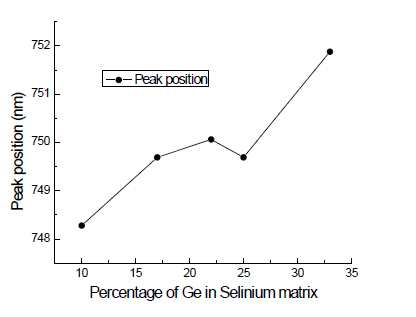
In general, relaxation refers to the return of a perturbed system to equilibrium. In dielectric materials, the dielectric polarization depends on the applied electric field (E). As the electric field changes, polarization relaxes toward a new equilibrium. If the surface charge redistribution takes a very long time, it results in dielectric absorption, which is characterized by a long relaxation time. Moreover, relaxation time is temperature-dependent. In semiconducting glasses, increasing temperature enhances the number of charge carriers, which in turn increases electrical conductivity and leads to faster relaxation due to increased atomic mobility. Slow relaxation is typically associated with aging phenomena in glasses, whereas fast relaxation is indicative of nonaging behavior.
Figure 5:Exponent β as a function of percentage of Ge in Selenium matrix.
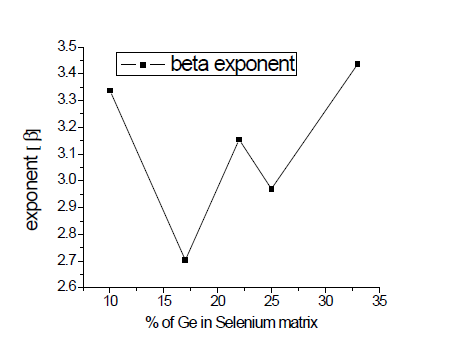
We can thus relate the observed compressed decay exponents in compositions lying within the intermediate phase (e.g., Ge₂₂Se₇₈ and Ge₂₅Se₇₅) to the presence of large dynamic heterogeneities. These compositions belong to a stress-free regime, where a concomitant decrease in the β exponent is observed (as shown in Figure 5), along with a decrease in the relaxation time (τ), indicating faster relaxation. This behavior aligns well with the Bouchard and Pitard model, which explains compressed decay exponents as a result of the release of internal stress and strain [18,19]. We propose that the underlying structural mechanism is the rearrangement or localized micro-collapse of groups of atoms or tetrahedral (clusters), a process reminiscent of ballistic-like dynamics observed in these intermediate-phase compositions. This avalanche-like dynamic is also found in various other systems, such as martensitic transformations [20,21] and metallic glass deformation [22-24]. In contrast, the stress-rigid phase, particularly near the chemical threshold composition Ge₃₃Se₆₇, represents a chemically ordered state. At this composition, Ge-Se heteropolar bonds dominate, cross-linking is complete, free volume is minimal, and fully 2D layered structure forms. Here, the relaxation time τ is reduced (faster relaxation) compared to the intermediate phase, and the β exponent increases significantly, indicating uniform (less heterogeneous) dynamics.
In the Ge₁₀Se₉₀ glass composition, the absence of the first sharp diffraction peak (FSDP) in X-ray diffraction implies that tetrahedral units are not interconnected, and the selenium matrix consists of long chains or rings. Germanium atoms act as cross-linking sites but remain sparsely distributed, with little correlation between tetrahedral units [10,11]. This leads to a large free volume, gradual increase in cross-linking and rigidity, and increased compactness due to micro-collapses of selenium structures. The structural relaxation dynamics here are sluggish, resembling solid-like behavior, reflected in a large τ (slow relaxation) and high β exponent, indicating more uniform inhomogeneities. At Ge₁₅Se₈₅, the appearance of the FSDP marks the beginning of correlations among tetrahedral units [10,11]. In the Ge₁₇Se₈₃ composition, cornersharing of tetrahedral units begins, free volume decreases, crosslinking density increases, and compactness grows. Simultaneously, a 2D network structure starts to evolve, where some groups of tetrahedra form clusters exhibiting compressed decay behavior. Overall, the β exponent serves as a valuable measure of dynamic heterogeneity: a lower β indicates greater heterogeneity, while a higher β reflects more uniform (homogeneous) dynamics.
Our previous investigations on glass transition relaxation dynamics revealed a stretched exponential time dependence in weakly connected clusters [25], characterized by a Kohlrausch- Williams-Watts (KWW) exponent β ranging between 0 and 1. In contrast, the current UV-visible spectroscopy data obtained at room temperature shows transient relaxation behavior with a compressed exponential form for strongly connected clusters. This indicates the presence of two distinct types of relaxation mechanisms stretched and compressed each arising from different structural origins. In stretched exponential relaxation, damping is strong [26], whereas in compressed exponential relaxation, damping is weak. The compressed KWW exponent β for the present samples (see Figure 5) falls within the nonexponentiality bounds of 2.7< β<3.5, reinforcing the structural differentiation. This variation in damping behavior points to a different type of motion compared to the viscous flow typically observed during glass transition in disordered systems. At room temperature, the relaxation dynamics appear to be ballistic, suggesting that tetrahedral clusters move collectively as rigid units. This behavior is more pronounced in the stress-rigid phase (notably at the chemical threshold composition Ge₃₃Se₆₇) than in the fragile glass compositions (Ge₁₀Se₉₀ to Ge₁₉Se₇₉), where β increases continuously, and implying faster cluster dynamics. This acceleration may be attributed to an enhancement in charge carrier density in more rigid networks, in contrast to fragile systems, which often exhibit slow relaxation due to trapped internal stresses, structural defects, and dangling bonds.
Furthermore, our ongoing investigation of the unusual dynamic linearity observed in the compositions shown in Figure 6 offers additional insights. The data reveal five distinct nonlinearities, which are interpreted based on the structural characteristics of the glass network. In Ge₁₀Se₉₀, the structural units are sparsely distributed, while in Ge₃₃Se₆₇, homopolar bonds are largely absent. This leads to intermediate nonlinearity in Ge₁₀Se₉₀ and maximum linearity in the stress-rigid Ge₃₃Se₆₇ composition, reinforcing the link between network connectivity and relaxation dynamics.
Figure 6:Linearity as a function of compositions.
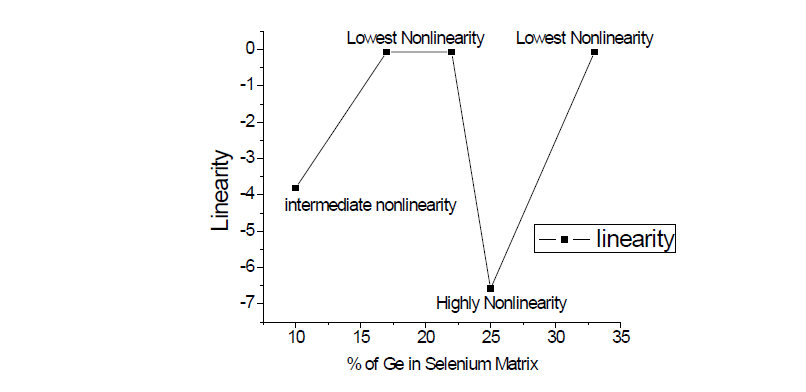
Conclusion
In the present study, transitory relaxation behavior was analyzed across various Ge-Se glass compositions namely, Ge₁₀Se₉₀, Ge₁₇Se₈₃, Ge₂₂Se₈₈, Ge₂₅Se₇₅, and Ge₃₃Se₆₇. The analysis reveals that the relaxation follows a compressed Kohlrausch-Williams- Watts (KWW) form, as indicated by exponent values (β) greater than one. While values of β<1 signify stretched exponential decay typically seen in diffusive processes, the observed β values in the range 2.5<β<3.5 confirm a compressed exponential relaxation, implying ballistic-like dynamics. These compressed dynamics are attributed to the micro-collapse of tetrahedral units within the glass network, pointing to a solid-like behavior at the mesoscopic scale. In such systems, the relaxation time reflects ballistic motion rather than thermally activated diffusion. A notable observation is the inverse correlation between relaxation time and peak position denser and more rigid glasses exhibit shorter relaxation times. In the context of light-matter interaction, the electromagnetic field not only transfers energy but also imparts momentum, exerting pressure on the surface of the glass. This interaction alters the surface properties, resulting in a redshift of the UV absorption band toward the visible region. Such changes are indicative of underlying structural relaxation. The analysis reveals both linear and nonlinear trends across the compositions studied, underscoring variations in structural rigidity and network connectivity. To comprehensively interpret the unusually high exponent values in the range of 2.5 to 3.5, a robust theoretical model is necessary. These observations strongly suggest the presence of uniform inhomogeneities and fragile structural features, particularly around the chemical threshold compositions. Notably, the manifestation of ballistic-like dynamics even at room temperature supports the idea of enhanced local order and short-range rigidity in specific compositional regimes.
Author Contribution
Author did data analysis and wrote the manuscript.
Declaration
The author received no funding for this work and declares no conflict of interest.
References
- Lubchenko V, Wolynes PG (2007) Theory of structural glasses and super cooled liquids. Ann Rev Phys Chem 58: 235-266.
- Kievelson SA, Tarjus G (2008) In search of a theory of super cooled liquids. Nat Mat 7(11): 831-833.
- Phillips JC (1979) Topology of covalent non-crystalline solids I: Short range order in chalcogenide alloys. J of Non-Cryst Solids 34(2): 153-181.
- Phillips JC (1981) Topology of covalent non-crystalline solids II: Medium range order in chalcogenide alloys and A Si(Ge). J of Non-Cryst Solids 43(1): 37-77.
- Thorpe MF (1983) Continuous deformations in random networks. J of Non-Cryst Solids 57(3): 355-370.
- Stankiewicz A, Bojanowska M (2025) Optimal choice of the regularization parameter for direct identification of polymers relaxation time and frequency spectra. Polymers 17(1): 31.
- Wang WH (2019) Dynamic relaxations and relaxation property relationships in metallic glasses. Progress in Materials Science 106: 100561.
- Wang WH (2012) The elastic properties, elastic models and elastic perspective of metallic glasses. Progress in Materials Science 57(3): 487-656.
- Nedelcu N, Chiroiu V, Rugina C, Munteanu L, Ioan R, et al. (2020) Dielectric properties of GeSbSe glasses prepared by the conventional melt quenching method. Results in Physics 16: 102856.
- Sharma D, Sampath S, Lalla NP, Awasthi AM (2005) Mesoscopic organization and structural phases in network-forming GexSe1-x J of Physica B 357: 290.
- Sharma D, Awasthi AM (2023) Novel anomalies of soft quasi localized glassy mode in the vicinity of boson peak frequency. Indian Journal of Physics 97(10): 3103.
- Awasthi AM, Sampath S (2002) Thermo kinetic anomalies across rigidity threshold in GexSe1-x . Material Transaction 43(8): 2046-2049.
- Awasthi AM, Sampath S (2001) Template compositional behavior of relaxation time divergence in GexSe1-x. Material Sci Eng 304: 476-479.
- Hodge IM (1983) Effects of annealing and prior history on enthalpy relaxation in glassy polymer comparison of five polymers. Macromolecule 16: 898.
- Sharma D, Ingale A, Awasthi AM (2005) Confined acoustic modes and spectral determination of network connectivity: Raman signatures of nanometric structures in g-GexSe1-x. Solid State Communications 134(10): 653-658.
- Verhaegh NAM, Asnaghi D, Lekkerkerker HNW, Giglio M, Cipelletti L (1997) Transient gelation by spinodal decomposition in colloid-polymer mixtures. Physica (A) 242 (1-2): 104-118.
- Poon WCK, Starrs L, Meeker SP, Moussaïd A, Evans RML, et al. (1999) Delayed sedimentation of transient gels in colloid-polymer mixtures: Dark field observation, rheology and dynamic light scattering studies. Faraday Discussion 112: 143-154.
- Bouchard JP, Pitard E (2001) Anomalous dynamic light scattering in soft glassy gels. Eur Phys J E 6: 231-236.
- Ferrero EE, Martens K, Barrat JL (2014) Relaxation in yield stress systems through elastically interacting activated events. Phys Rev Lett 113: 248301.
- Muller L, Waldorf M, Gutt C, Grubel G, Madsen A, et al. (2011) Slow ageing dynamics and avalanches in a Gold-cadmium alloy investigated by X-ray photon correlation spectroscopy. Phys Rev Lett 107(10): 105701.
- Sanborn C, Fudwig KF, Rogers MC, Sutton M (2011) Direct measurement of microstructural avalanches during the martensitic transition of cobalt using coherent X-ray scattering. Phys Rev Lett 107: 015702.
- Fan Y, Iwashita T, Igami T (2015) Crossover from localized to cascade relaxations in metallic glasses. Phys Rev Lett 115(4): 045501.
- Antonaglia J, Wright WJ, Gu X, Byer RR, Hugnagel TC, et al. (2014) Bulk metallic glasses deform via slip avalanches. Phys Rev Lett 112(15): 155501.
- Krisponeit JO, Pitikaris S, Avila KE, Kuchemann S, Kruger A, et al. (2014) Crossover from random three-dimensional avalanches to correlated nano shear bands in metallic glasses. Nat Comm 5: 3616.
- Deepak S (2019) Fragility and cooperative dynamics correlations in GexSe1-x chalcogenide glasses. J Non-Cryst Solids 516: 67-70.
- Zakery A, Elliot SR (2003) Optical properties and applications of chalcogenide glasses: a review. J Non-Cryst Solids 330(1-3): 1-12.
© 2025 © Deepak Sharma. This is an open access article distributed under the terms of the Creative Commons Attribution License , which permits unrestricted use, distribution, and build upon your work non-commercially.
 a Creative Commons Attribution 4.0 International License. Based on a work at www.crimsonpublishers.com.
Best viewed in
a Creative Commons Attribution 4.0 International License. Based on a work at www.crimsonpublishers.com.
Best viewed in 







.jpg)






























 Editorial Board Registrations
Editorial Board Registrations Submit your Article
Submit your Article Refer a Friend
Refer a Friend Advertise With Us
Advertise With Us
.jpg)






.jpg)














.bmp)
.jpg)
.png)
.jpg)










.jpg)






.png)

.png)



.png)






